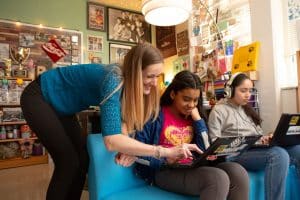Science of Learning: The Engine that Powers Competency-Based Schools
CompetencyWorks Blog
What Is Good Teaching?
“Good teaching is good teaching” is a common refrain in the education world. We nod and validate the unspoken definition of “good teaching.” If we pause and truly think about it, what defines good teaching? Where are the barometers and requirements? Fortunately, we can look to the body of research on how people learn, the Science of Learning, for direction. This knowledge base is particularly useful for competency-based learning. It answers the question of how to teach so students master the information and skills they need. Put simply, the Science of Learning is a tool for schools and organizations looking to design around evidence of learning, the anchor of competency-based learning. It helps to align teaching with new and exciting forms of assessment.

The Relationship Between Science of Learning and Competency-Based Learning
The first “stepping stone” on the way to mastery is taking in and making sense of information. What can we learn from the Science of Learning here? If we don’t attend to information, it won’t be remembered (Latcher et al., 2004), and if we are overloaded with too much information our brains aren’t able to make sense of it (Mayer, 2019). Fortunately, there are strategies supported by research that capture and sustain attention and avoid taxing working memory. For example, educators can consider using prediction to capture attention and segmenting information into meaningful groups to alleviate cognitive overload (Willis, 2010; Baddeley, 2000). This differs from traditional schooling where students are expected to absorb information while the teacher speaks.
A critical component of competency-based learning’s emphasis on mastery is transfer of learning. Transfer is the ability to apply knowledge and skills to a new context. Interestingly enough, the conditions of instruction that make performance improve rapidly often fail to support transfer (Bjork & Bjork, 2011). What conditions do lead to transfer then? Those that require learners to actively engage. In turn, this slows down the rate of apparent learning. For example, educators can incorporate retrieval practice and multimodal instruction into their teaching. Competency-based learning provides the space (and time) for students to master skills in a transferable manner; the Science of Learning informs what this space looks like.
Research suggests that most of us aren’t good at judging our own learning process, and it is often hard for us to tell when we are or are not learning (Karpicke et al., 2009). The good news is that metacognitive skills, our awareness of our learning, can be fostered like any other skill. In fact, metacognition has been demonstrated as one of the most effective teaching interventions over decades of research (Hattie, 2008). Furthermore, one study reported the impact of metacognition to be equivalent to an additional eight months of progress (Australian Teaching and Learning Toolkit, 2021). This is worth noting, because empowering students to make important decisions about their learning process and demonstrating how they’ve learned is an essential part of competency-based learning that relies on strong metacognition.

In my work with schools, I’ve noticed that competency-based learning often begins with altering assessments to demonstrate mastery instead of memorization. This important work is an exciting forward momentum. A natural inconsistency then emerges where the way students are learning doesn’t align with the new goal of the assessment. In other words, there is a need to shift instruction from more traditional teaching focused on memorization to teaching that promotes mastery and transfer. This is where the Science of Learning comes in. It gives clear direction on how to teach for mastery by delivering content in a meaningful and engaging manner. Put differently, the Science of Learning is a means to accelerate the shift to competency-based learning.
What Does This Look Like in Practice?
I found the Science of Learning as a middle school English teacher. Much of the research supported what I had known instinctively from my work with students. I finally had the scientific explanation for my best practices. At the same time, aspects of the research challenged some of my instructional practices. The area that it challenged me the most was learning how to provide feedback on my students’ writing that contributed to their mastery of composition skills.
Allow me to rewind a bit for context. I had the opportunity to teach students two years in a row. In the first year, I pored over the short stories they had written and spent hours over the weekend grading. My grading process included comments on their documents and a grade that was calculated with a rubric. Students were required to initial the comments to acknowledge their understanding, and I shared the same feedback with their parents at the upcoming conference. Sounds thorough, right?

The following year, I sat down to grade the same students’ memoirs. I was surprised to find many of the same mistakes being made a year later. I turned to the Science of Learning for answers and identified two mistakes I had made. First, I didn’t give my students an opportunity to do anything with the feedback, and second, I gave grades and comments at the same time (Williams, 2016). Research has found that students who have the opportunity to correct their mistakes achieved better than their peers who did not have the same opportunity (Williams 2019, Boulet et al, 1990; Day & Cordon, 1993). Additionally, studies have shown that when grades are paired with comments, the impact of the comments (associated with a 30% gain in student progress) is negated (Butler, 1988).
What did I do differently? As a result of my learning, I changed the format of my comment to a question or an action statement, such as, “This paragraph would fit better somewhere else, can you find it?” I also gave comments first, an opportunity to revise, and a grade at the end. Lastly, I spent more time explaining to my students what the feedback was for and how to use it. This meant I no longer needed to give extensive comments on each paper. I share this anecdote to illuminate the power of the Science of Learning particularly in the context of developing mastery. In addition, I hope to inspire other educators to reap the benefits as I did.
Learn More
- What if Educational Policy Was Shaped by the Learning Sciences? (Part 1)
- What if Educational Policy Was Shaped by the Learning Sciences? (Part 2)
- What the Learning Sciences Tell Us About Competency Education
- Key Terms to Understand the Learning Sciences
 Natalie Young is an experienced educator who holds a master’s degree from Teachers College at Columbia University and has served over 350 diverse learners ages 3-13. Natalie authored curricula that were recognized at regional conferences and on expert panels. In addition, Natalie led and coordinated school- and state-wide professional development programming. After witnessing the power of the Science of Learning as a teacher and trainer, Natalie is devoted to making a difference for students globally by way of educators as the Director of Learning & Development at COGx. || LinkedIn
Natalie Young is an experienced educator who holds a master’s degree from Teachers College at Columbia University and has served over 350 diverse learners ages 3-13. Natalie authored curricula that were recognized at regional conferences and on expert panels. In addition, Natalie led and coordinated school- and state-wide professional development programming. After witnessing the power of the Science of Learning as a teacher and trainer, Natalie is devoted to making a difference for students globally by way of educators as the Director of Learning & Development at COGx. || LinkedIn